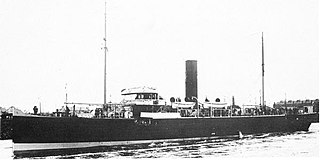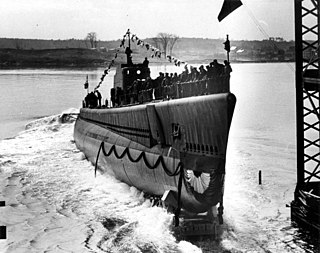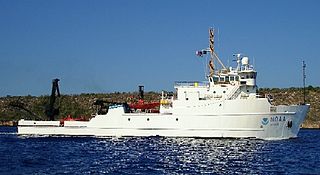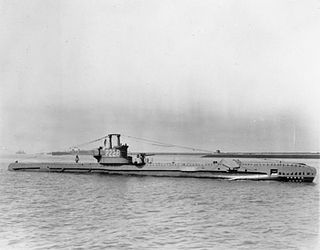
German submarine U-552 was a Type VIIC U-boat built for Nazi Germany's Kriegsmarine for service during World War II. She was laid down on 1 December 1939 at Blohm & Voss in Hamburg as yard number 528, launched on 14 September 1940 and went into service on 4 December 1940. U-552 was nicknamed the Roter Teufel after its mascot of a grinning devil which was painted on the conning tower. She was one of the more successful of her class, operating for over three years of continual service and sinking or damaging 35 Allied ships with 164,276 GRT and 1,190 tons sunk and 26,910 GRT damaged. She was a member of 21 wolf packs.

German submarine U-155 was a Type IXC U-boat of Nazi Germany's Kriegsmarine built for service during World War II. Her keel was laid down on 1 October 1940 by DeSchiMAG AG Weser in Bremen as yard number 997. She was launched on 12 May 1941 and commissioned on 23 August with Kapitänleutnant Adolf Piening in command. Piening was relieved in February 1944, by Oberleutnant zur See Johannes Rudolph.

Q-ships, also known as Q-boats, decoy vessels, special service ships, or mystery ships, were heavily armed merchant ships with concealed weaponry, designed to lure submarines into making surface attacks. This gave Q-ships the chance to open fire and sink them. The use of Q-ships contributed to the abandonment of cruiser rules restricting attacks on unarmed merchant ships and to the shift to unrestricted submarine warfare in the 20th century.

USS Wahoo (SS-238) was a Gato-class submarine, the first United States Navy ship to be named for the wahoo. Construction started before the U.S. entered World War II, and she was commissioned after entry. Wahoo was assigned to the Pacific theatre. She gained fame as an aggressive and highly successful submarine after Lieutenant Commander Dudley Walker "Mush" Morton became her skipper. She was sunk by Japanese aircraft in October 1943 while returning home from a patrol in the Sea of Japan.

USS Blackfish (SS-221), a Gato-class submarine, was the only ship of the United States Navy to be named for the blackfish.

USS Kingfish (SS-234), a Gato-class submarine, was the first ship of the United States Navy to be named for the kingfish.

USS YP-422 was a United States Navy yard patrol (YP) boat that served the United States Navy in World War II from 1942 to 1943. Built in 1941 as the fishing trawler Mist, she was acquired by the US Navy in June 1942 and was converted for naval use by George Lawley & Son of Neponset, Massachusetts. She was commissioned on 28 July 1942 and was put into service to patrol the waters around the Boston Navy Yard. The vessel was lightly armed with a 3-inch gun and two .30 caliber machine guns.

German submarine U-85 was a Type VIIB U-boat of Nazi Germany's Kriegsmarine during World War II.

The NOAA Ship Nancy Foster is a National Oceanic and Atmospheric Administration research vessel. The ship is named for Dr. Nancy Foster, who was the director of the National Marine Fisheries Service’s Office of Protected Resources from 1986 until 1993, and the director of the National Ocean Service from 1997 until her death in 2000. nd United States Gulf Coast

HMS Splendid was a third-batch S-class submarine built for the Royal Navy during World War II. She was laid down on 7 March 1941 and launched on 19 January 1942. After an initial patrol through the Bay of Biscay to Gibraltar, Splendid conducted two patrols in the Mediterranean Sea; one was abandoned after technical problems and on the other she sank two Italian ships. On her next patrol, the submarine attacked two Italian convoys, sinking an Italian destroyer in the second attack. Based in Algiers, the boat operated north of Sicily, sinking six Italian ships, including two tankers and two heavy merchant ships. Splendid was detected by a German destroyer on 21 April 1943 while patrolling off Naples, Italy; the submarine was attacked with depth charges by the destroyer and forced to surface, after which she was scuttled and her surviving crew members taken prisoner. She was the most successful British submarine by tonnage sunk between November 1942 and May 1943.
Vorpostenboot, also referred to as VP-Boats, flakships or outpost boats, were German patrol boats which served during both World Wars. They were used around coastal areas and in coastal operations, and were tasked with – among other things – coastal patrol, ship escort, and naval combat.

Naval trawlers are vessels built along the lines of a fishing trawler but fitted out for naval purposes; they were widely used during the First and Second World Wars. Some—known in the Royal Navy as "Admiralty trawlers"— were purpose-built to naval specifications, others adapted from civilian use. Fishing trawlers were particularly suited for many naval requirements because they were robust vessels designed to work heavy trawls in all types of weather, and had large clear working decks. A minesweeper could be created by replacing the trawl with a mine sweep. Adding depth charge racks on the deck, ASDIC sonar below, and a 3-inch (76 mm) or 4-inch (102 mm) gun in the bow equipped the trawler for anti-submarine duties.

German submarine U-701 was a Type VIIC U-boat built for the Nazi Germany's Kriegsmarine that served in the North Atlantic during World War II. It was launched on 16 April 1941 under the command of Kapitänleutnant Horst Degen, with a crew of 43.
HMT Bedfordshire (FY141) was an armed naval trawler in the service of the Royal Naval Patrol Service during World War II. Transferred to the East Coast of the United States to assist the United States Navy with anti-submarine patrols, she was staffed by a British and Canadian crew. Bedfordshire was sunk by the German submarine U-558 on 11 May 1942 off the coast of Ocracoke Island in the Outer Banks of North Carolina, with the loss of all hands.
German submarine U-402 was a Type VIIC U-boat built for Nazi Germany's Kriegsmarine for service during World War II.

SM U-117 was a Type UE II long-range minelayer submarine of the Imperial German Navy. She was laid down in 1917, at Hamburg, Germany, by Aktiengesellschaft Vulcan and launched on 10 December 1917. She was commissioned in the Imperial German Navy on 28 March 1918, with Kapitänleutnant Otto Dröscher in command. After shakedown, U-117 was posted to the U-Kreuzer Verband on 1 June 1918. Over the next five weeks, she completed fitting out at Kiel.

The Action off Noordhinder Bank on 1 May 1915 was a naval engagement between four British naval trawlers, supported by a flotilla of four destroyers and a pair of German torpedo-boats from the Flanders Flotilla. The action began when the two torpedo boats were sent to rescue the crew of a reconnaissance seaplane that had been forced to alight by engine-trouble and to attack the trawlers. The Germans engaged the trawlers; British destroyers from Harwich Force appeared and the German ships ran for home but were sunk.
The Torpedo Alley, or Torpedo Junction, off North Carolina, is one of the graveyards of the Atlantic Ocean, named for the high number of attacks on Allied shipping by German U-boats in World War II. Almost 400 ships were sunk, mostly during the Second Happy Time in 1942, and over 5,000 people were killed, many of whom were civilians and merchant marines. Torpedo Alley encompassed the area surrounding the Outer Banks, including Cape Lookout and Cape Hatteras.
German submarine U-576 was a Type VIIC U-boat of Nazi Germany's Kriegsmarine during World War II. She carried out five patrols, sinking four ships of 15,450 gross register tons (GRT) and damaging two more of 19,457 GRT. She was sunk on 15 July 1942 by depth charges from two US aircraft and gunfire from a merchant ship, near the East Coast of the United States. The wreck was discovered in August 2014.














